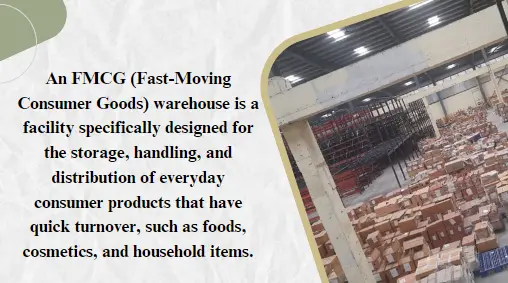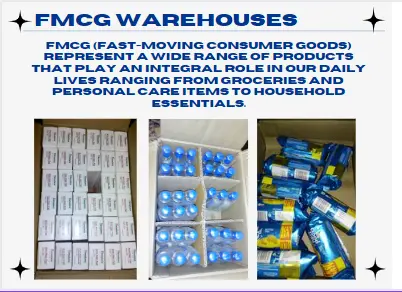FMCG warehouses (Fast Moving Consumer Goods) stand as silent sentinels, conducting the dance of logistics amidst the constant noise of supply and demand. Within their complex scope, a Masterpiece of organization unfolds as products travel from production lines to waiting branches of consumers. These warehouses, like monsters of efficiency, store innumerable goods, each waiting for the moment to cross the last leg of its journey. The towering pallets, the endless corridors and the hum of machinery echoing in the air make the heartbeat of industry stop.
Here, amidst Jumbling corridors, every inch of space is a battlefield in the war of efficiency and speed, where optimization reigns supreme. Yet, beyond mechanical precision, lies an invisible battlefield of strategy and innovation, where companies compete not just for shelf space, but for the hearts and minds of consumers. In this war of brands, FMCG warehouses have emerged as silent battlefields, where the spoils of victory are measured not just in products moved, but also in lasting impressions imprinted in the fabric of consumer consciousness.
- Introduction:
- Foundations of FMCG Warehouses:
- Challenges in FMCG Warehousing:
- Technology Integration in FMCG Warehouses:
- Sustainable Practices in FMCG Warehousing:
- Future Trends and Innovations:
- Collaboration and integration in the FMCG supply chain:
- Supplier Collaboration:
- Integration with retailers:
- Timely and efficient delivery:
- Reducing Lead Times:
- Minimizing stockouts and overstock situations:
- Management of seasonal demand:
- Enabling Just-in-Time Inventory:
- Adopting Consumer Preferences:
- Temperature-controlled storage for perishable goods:
- Efficient Order Fulfillment:
- Support of e-commerce operations:
- Data-Driven Decision Making:
- Ensuring product quality and safety:
- Sustainability and Environmental Impact:
- Facility of Product Returns and Reverse Logistics:
- Increasing Supply Chain Visibility:
- Meeting Regulatory Compliance:
- Conclusion:
- Frequently Asked Questions:
- What is an FMCG warehouse?
- Why are FMCG warehouses essential in the supply chain?
- How do FMCG warehouses handle products with short shelf life?
- What technologies are commonly used in FMCG warehouses?
- How do FMCG warehouses manage seasonal variations in demand?
- How do FMCG warehouses contribute to sustainability?
- What role do FMCG warehouses play in e-commerce operations?
- How do FMCG warehouses handle temperature-sensitive products?
- What is the importance of data analytics in FMCG warehouses?
- How do FMCG warehouses contribute to efficient order fulfillment?
- How do FMCG warehouses manage returns and reverse logistics?
- What measures do FMCG warehouses take to ensure product quality and safety?
- How do FMCG warehouses enhance supply chain visibility?
- How do FMCG warehouses contribute to meeting sustainability goals?
- How do FMCG warehouses comply with regulatory standards?
Introduction:
FMCG (Fast-moving consumer goods) represent a wide range of products that play an integral role in our daily lives ranging from groceries and personal care items to household essentials. Behind the uninterrupted availability of these products is a complex and dynamic network of FMCG warehouses. This blog will explore the complexities of FMCG warehouses, their functions, challenges, and innovations driving the efficiency of this critical component in the supply chain.

Foundations of FMCG Warehouses:
Diverse Product Portfolio:
FMCG warehouses deal with a vast range of products, including foods, cosmetics, cleaning supplies, and more.
Efficient handling of diverse products requires sophisticated inventory management systems and specialized storage solutions.
Just-in-Time Inventory:
FMCG warehouses often operate on a just-in-time inventory model to reduce storage costs and ensure the freshness of perishable goods.
This model demands accuracy in predicting demand and maintaining optimal stock levels.
Challenges in FMCG Warehousing:
Short shelf life:
Many FMCG products have short shelf lives, requiring warehouses to manage inventory carefully to prevent product expiration and wastage.
Efficient inventory turnover and first-in, first-out (FIFO) systems are important for managing perishable goods.
Demand Volatility:
Consumer preferences and demand for FMCG products can be highly volatile, influenced by factors such as seasonality, promotions, and trends.
Warehouses must be agile to adapt to sudden changes in demand and prevent stock-out or overstock situations.
Temperature and storage conditions:
Some FMCG products, such as frozen foods or pharmaceuticals, require specific temperatures and storage conditions.
Implementing temperature-controlled areas and following regulatory standards are essential to maintaining product quality.

Technology Integration in FMCG Warehouses:
Automatic Order Selection:
FMCG warehouses take advantage of automated order-picking systems like conveyors and robotic systems to speed up the fulfillment process.
Automation reduces errors, reduces labor costs, and increases overall operational efficiency.
RFID and IoT Tracking:
RFID technology and Internet of Things (IoT) devices are used for real-time tracking and monitoring of FMCG inventory.
Increased visibility into the supply chain allows for better decision-making and reduces the risk of stockouts or excess inventory.
Data Analysis for Demand Forecasting:
Advanced data analytics tools analyze historical data, market trends, and external factors to accurately forecast demand for FMCG products.
Predictive modeling helps warehouses optimize stock levels, ensuring products are available when and where they are needed.

Sustainable Practices in FMCG Warehousing:
Eco-Friendly Packaging:
FMCG warehouses are increasingly adopting eco-friendly packaging materials to reduce environmental impact.
Sustainable packaging initiatives contribute to corporate social responsibility goals and meet the growing demand for environmentally conscious products.
Efficient Reverse Logistics:
FMCG warehouses optimize reverse logistics processes for product returns, reducing waste and facilitating recycling or repackaging of returned items.
Applying circular economy principles helps reduce the environmental impact of product returns.

Future Trends and Innovations:
Blockchain for Traceability:
Blockchain technology is being explored to increase traceability in the FMCG supply chain.
Improved transparency in the supply chain helps in tracking the origin, management, and distribution of products, ensuring authenticity and quality.
Drone for Inventory Management:
Drones are being tested for inventory management tasks in large FMCG warehouses.
Drone technology provides quick and accurate scanning of inventory, reducing the time and labor required for routine stock checks.
Collaboration and integration in the FMCG supply chain:
Supplier Collaboration:
Strong collaboration with suppliers is important for FMCG warehouses to maintain a steady supply of products.
Timely communication and data sharing help align inventory levels with market demand.
Integration with retailers:
Seamless integration with retailers through advanced systems facilitates efficient order processing and delivery.
Real-time data exchange ensures that FMCG warehouses can respond immediately to changes in demand or promotions.
The importance of FMCG (Fast-Moving Consumer Goods) warehouses is paramount in the global supply chain, impacting the efficiency, accessibility, and availability of a wide range of everyday products. Here are the key reasons that highlight the importance of FMCG warehouses:
Timely and efficient delivery:
FMCG warehouses play a vital role in ensuring timely and efficient delivery of fast-moving consumer goods to retailers, ensuring that products reach shelves quickly.
Reducing Lead Times:
By strategically positioning warehouses near key markets, FMCG companies can significantly reduce lead times, allowing faster response to changes in consumer demand.
Minimizing stockouts and overstock situations:
FMCG warehouses help maintain optimal inventory levels, preventing stockouts that can lead to reduced sales and overstock situations that result in additional costs.
Management of seasonal demand:
Seasonal variations in demand for FMCG products are common. Warehouses help manage these fluctuations efficiently, ensuring that products are available in adequate quantities during peak seasons.
Enabling Just-in-Time Inventory:
Many FMCG warehouses operate on a just-in-time inventory model, allowing companies to reduce storage costs and optimize inventory turnover, especially for products with short shelf lives.
Adopting Consumer Preferences:
FMCG warehouses must adapt to changes in consumer preferences, reacting quickly to trends and changes in demand to ensure the right products are available in the market.
Temperature-controlled storage for perishable goods:
FMCG products often include perishable items such as fresh produce, dairy, and frozen foods. Warehouses equipped with temperature-controlled storage facilities maintain the quality and safety of these commodities.
Efficient Order Fulfillment:
With the use of advanced technologies such as automated picking systems and robotics, FMCG warehouses can streamline order fulfillment processes, reduce errors, and increase overall operational efficiency.
Support of e-commerce operations:
The rise of e-commerce has increased complexity in the supply chain. FMCG warehouses are important to support online retail operations, seamlessly integrating with e-commerce platforms to fulfill orders quickly and accurately.
Data-Driven Decision Making:
FMCG warehouses leverage data analytics to forecast demand, optimize inventory levels, and improve overall supply chain efficiency. Data-driven insights help make informed decisions about stock replenishment and distribution strategies.
Ensuring product quality and safety:
Warehouses implement stringent quality control measures to ensure that FMCG products meet safety standards and regulatory requirements while maintaining consumer trust and confidence.
Sustainability and Environmental Impact:
FMCG warehouses are increasingly adopting sustainable practices, including eco-friendly packaging materials and efficient reverse logistics processes, which are contributing to the overall sustainability goals of FMCG companies.
Facility of Product Returns and Reverse Logistics:
Efficient management of product returns is essential in the FMCG sector. Warehouses play an important role in reverse logistics, managing returned products, and facilitating recycling or repackaging.
Increasing Supply Chain Visibility:
FMCG warehouses contribute to increased supply chain visibility through the use of technologies such as RFID and IoT, providing real-time tracking and monitoring of inventory across the supply chain.
Meeting Regulatory Compliance:
Warehouses have to comply with various regulations governing the storage and distribution of FMCG products. Compliance with safety, health, and environmental standards is important for both legal and ethical reasons.

Conclusion:
FMCG warehouses serve as pivots in the supply chain, ensuring fast and efficient movement of products from manufacturers to retailers and ultimately to the hands of consumers. The challenges posed by short shelf life, demand volatility, and the need for special storage conditions require FMCG warehouses to adopt innovative solutions and technologies. As the industry evolves, the adoption of sustainability, advanced technologies, and collaborative practices will be critical in shaping the future of FMCG warehousing. Adaptability in the complex world of FMCG warehouses and commitment to excellence are key drivers of success in this dynamic and important sector.
For similiar Topics, please click here.
Frequently Asked Questions:
What is an FMCG warehouse?
An FMCG (Fast-Moving Consumer Goods) warehouse is a facility specifically designed for the storage, handling, and distribution of everyday consumer products that have quick turnover, such as foods, cosmetics, and household items.
Why are FMCG warehouses essential in the supply chain?
FMCG warehouses are essential as they ensure timely and efficient delivery of fast-moving consumer goods to retailers. They play a vital role in reducing lead times, managing inventory levels, and adapting to changes in consumer demand, thereby supporting overall supply chain efficiency.
How do FMCG warehouses handle products with short shelf life?
FMCG warehouses use just-in-time inventory models and implement efficient inventory turnover practices to handle products with short shelf lives. This ensures that goods remain fresh and reduces the risk of product expiry.
What technologies are commonly used in FMCG warehouses?
FMCG warehouses leverage a variety of technologies, including automated picking systems, RFID (radio-frequency identification), IoT (Internet of Things) devices, and data analytics for demand forecasting. These technologies increase order fulfillment efficiency, tracking, and overall warehouse management.
How do FMCG warehouses manage seasonal variations in demand?
FMCG warehouses anticipate and manage seasonal variations by adjusting inventory levels, optimizing storage space, and adopting flexible delivery strategies. This helps ensure that products are easily available during peak demand periods.
How do FMCG warehouses contribute to sustainability?
FMCG warehouses contribute to sustainability by adopting eco-friendly practices such as using sustainable packaging materials, optimizing reverse logistics for recycling, and implementing energy-efficient technologies to reduce environmental impact.
What role do FMCG warehouses play in e-commerce operations?
FMCG warehouses are key to supporting e-commerce operations by seamlessly integrating with online platforms. They fulfill online orders efficiently, ensuring that products are delivered to consumers quickly and accurately.
How do FMCG warehouses handle temperature-sensitive products?
FMCG warehouses equipped with temperature-controlled storage facilities handle temperature-sensitive products, such as frozen foods or pharmaceuticals, to maintain product quality and safety.
What is the importance of data analytics in FMCG warehouses?
Data analytics in FMCG warehouses is critical to forecasting demand, optimizing inventory levels, and making informed decisions. It helps understand consumer trends, improve supply chain efficiency, and proactively respond to market changes.
How do FMCG warehouses contribute to efficient order fulfillment?
FMCG warehouses contribute to efficient order fulfillment through the use of advanced technologies such as automated picking systems and robotics. These technologies streamline the order processing workflow, reduce errors, and increase overall efficiency.
How do FMCG warehouses manage returns and reverse logistics?
FMCG warehouses play a vital role in managing product returns and reverse logistics. They implement efficient processes to handle returned products, facilitating recycling, repackaging, or proper disposal in line with sustainability goals.
What measures do FMCG warehouses take to ensure product quality and safety?
FMCG warehouses implement stringent quality control measures to ensure that products meet safety standards and regulatory requirements. This includes regular inspections, adherence to hygiene practices, and compliance with industry regulations.
How do FMCG warehouses enhance supply chain visibility?
FMCG warehouses enhance supply chain visibility by using technologies such as RFID and IoT devices. These technologies provide real-time tracking and monitoring of inventory, leading to better decision-making and improved overall visibility across the entire supply chain.
How do FMCG warehouses contribute to meeting sustainability goals?
FMCG warehouses contribute to meeting sustainability goals by adopting eco-friendly practices, reducing waste through efficient reverse logistics, and using energy-efficient technologies. These efforts are in line with broader corporate social responsibility and sustainability initiatives.
How do FMCG warehouses comply with regulatory standards?
FMCG warehouses adhere to various regulatory standards governing safety, health, and environmental considerations. Compliance measures include implementing safety protocols, adhering to hygiene standards, and adhering to legal and ethical requirements.
